Diminuendo Chess
By D. T. Jagger
Copyright © 2003. All rights reserved.
Diminuendo Chess is a 43 cell hexagonal chess featuring a central doublearea 'transmutation' cell where each captured token is dropped and transmuted (usually having its powers thereby diminished) to the next token type in an agreed ranking sequence. Any token moving or capturing into the central cell is similarly 'transmuted' (after removing any previous occupant).
Setup
The board consists of an array of 42 hexagonal cells in 3 circuits around a double-hexagon core cell, making 43 cells in all. The 42 single hexagons are coloured regularly in 3 colours with no adjacent hexagons having the same colour, and the remaining doublecell is coloured distinctively. The files are lettered a to g, and the ranks numbered 1 to 8.
Each side starts with a king (K), queen (Q), 2 rooks (R), 3 bishops (B), 2 knights (N) and 6 pawns (P) as shown.
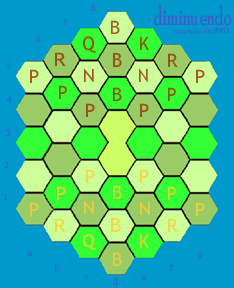
Rules
The following (except where noted otherwise) assumes the agreed ranking sequence of KQRNBP, which is my chosen 'variant' for presentation at this competition, and the only one I have so far explored in any depth.
Orthodox western chess rules apply where any uncertainty remains.
*1* Object and outcomes
The object is to 'checkmate' the opponent, i.e to render it impossible for him (legally) to escape check.
'Stalemate' occurs when a player (though not in check) is unable to make a legal move.
A draw occurs by agreement, on threefold repetition of a position by either player, or after 50 moves by each player without a capture.
A player may resign the game.
*2* Capture
Capture must always be of an opposing (not a friendly) token and is always by replacement.
Each token captured outside of the central 'transmution' cell is immediately dropped into the central cell where it...
- causes any current occupant to be removed from the board,
- transmutes into the next token (if any) in the agreed ranking sequence. If the captured token is the last ranked token then it is straightaway removed from the board, leaving the central doublecell empty.
*3* Moves
The moves are as illustrated.
Note on the doublecell: A token occupying the doublecell can be thought of as operating from both hexagonal halves of the doublecell at once, i.e as being in both parts at once! While its power to move, capture, offer check(s) and give mate is thereby enhanced, it is also vulnerable to being attacked (and captured with no reprieve) within either half of the doublecell.
In the chosen KQRNBP variant it is clear that a king cannot enter the doublecell because that would leave his side without a king. Neither can a queen enter the doublecell without being diminished. So in this variant no king or queen can ever reside within the doublecell.
Pawns (P) move one space straight forward (and never two), but capture one space sideways-forward into an adjacent cell. They promote on the first end cell they meet of any of the 7 files. They promote to any friendly piece (except a king) and cannot remain as pawns. There is no 'en passant'.
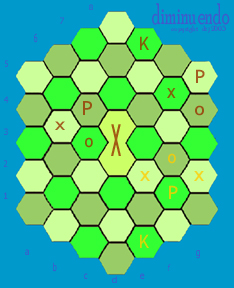
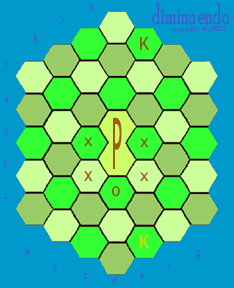
Knights (N) are the only leapers and move as in Glinski hexagonal chess, i.e 2 spaces straight ahead and 1 further space outwards and onwards, or 1 space onwards and 2 further spaces straight outwards and onwards.
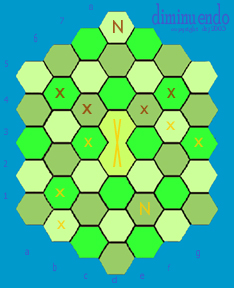
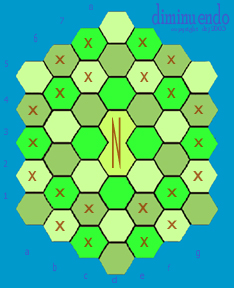
Bishops (B) too move as in Glinski hexagonal chess, i.e along diagonals of the same colour as their start square. They may pass between tokens which lie on other colours. They may pass horizontally across the middle of the doublecell, whether it is occupied or not.
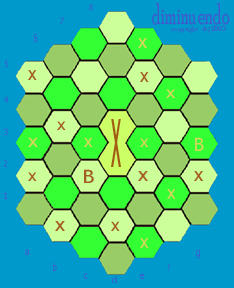
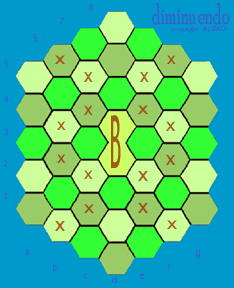
Rooks (R) move straight onwards in any direction. There is no castling.
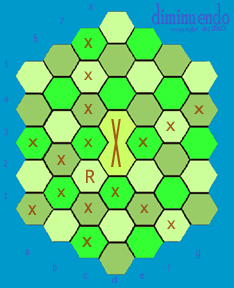
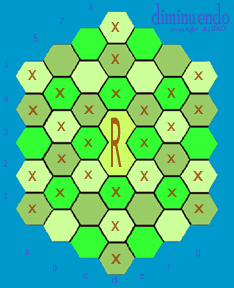
Queens (Q) move as either bishop or rook.
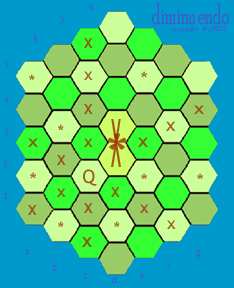
Kings (K) move one space to an adjacent space - i.e like a very limited rook.
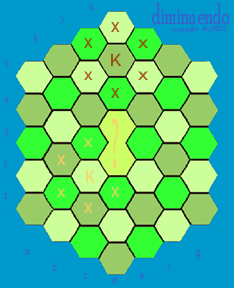
*4* 'Drop Check'
A player may make a capture on his turn which results in a transmuted opposing token apparently offering him check from the central doublecell before his opponent has ever moved a man. This I refer to as 'drop check'. In Diminuendo 'drop check' is not a valid check and is ignored, but only for that turn in which it occurred.
Thus it is possible for the player to use a just captured and transmuted enemy piece - one that may be 'drop-checking' him - to intercept a valid check.
Also he is quite entitled to 'drop check' himself as he offers check or gives mate to his opponent.
However, a 'drop check' may become a genuine check or checks once the opponent has taken his next go! He is free to move any of his men including the previously 'drop checking' token (whether to another checking position or not), and only once he has made a move is the new check or mate position considered. Typically an existing 'drop check' situation can be exploited for multiply checking a king.
That's all the rules folks!
Strategy and tactics
The game seems to me to be all about damage limitation and management over what can be a very subtle battle of attrition. You can only afford to take a rook if you are confident you can withstand an assault from the resultant central knight. Kings tend to find greater safety on the central vertical. You need to make your own transmuted central pieces work quickly before they are obliterated by another capture. You may need to abandon a few doublecell pawns along the way, though pawns can prove important in the end.Design background
'Diminuendo Chess' was inspired by the Chessvariants 43-space competition of 2003 and was created in March/April 2003.
I originally thought of naming the game 'Demotion Chess' but that name was taken. 'Diminishing Chess' seemed another possibility, but I eventually settled on 'Diminuendo' which stands on its own rather better than 'Diminishing'. The name is meant to reflect how tokens (typically) diminish in power with each capture.
I arrived at the board shape after playing around with inspiralling patterns, but it took me some while (and a few false starts) to come up with a reasonably satisfying use of the central doublecell 'oddity'. The game obviously is beholden to orthodox chess, shogi too perhaps (for the drop - though the colour doesn't change), various hexagonal chesses (Glinski deserves a special mention) and a host of other chess variants which contain singular features or 'oddities'. Scouring Pritchard reveals there is a variant of 'Replacement Chess' called 'Degraded Chess' by VRParton (1958) which may have been an unconscious influence and which contains the same idea of replacing pieces by others of diminishing power, though his ideas were applied in a more orthodox setting. The idea of using a multiple-cell (in this case the doublecell) had arisen from my experiments with other (unsatisfactory) boards for this competition, though I would be very surprised if the idea is original.
Diminuendo manages to orchestrate the gradual reduction in the power of the armies as the game progresses, so the board remains fairly populous well into the game and inordinate or one-sided slaughter is wellnigh impossible. Also the central 'oddity' of the doublecell helps to counter any gridlock. The game remains fluid with, usually, ample opportunities for attack and counterattack, threats and rebuttals.
One of the joys of the game is how one gets to play with unusual swarms of token types. In the chosen KQRNBP variant these are the theoretical (though not always achievable) maxima - neglecting pawn promotions - 1K, 1Q, 3R, 5N, 8B, 14P. Typically token types can disappear and reemerge as the game progresses. Games can be over in just a few moves (especially with novices - my first game was a mate in 5) or stretch into a prolonged and intricate contest.
A quick note on natural variants
During playtesting, which was both surprising and enjoyable, I came to conceive of the game as a family of 6! i.e factorial 6 or 720 members, each representing a different ranking sequence of the 6 token types. Like musical scales each might exhibit its own characteristic romance and allurement - or otherwise! Some 'scales' will be inversions of others and the name 'Crescendo Chess' might more properly apply to some (though that name is taken). I quite like the idea of multiple kings arising in certain variants - in which case a player would have to end his go with none of his kings in check, or lose! He might be tempted to ditch a king or two centrally. Some variants would permit a centrally situated and most powerful queen, or indeed a central king - which if obliterated would be a loss!
My design employs a 'rookish king' in order to facilitate checkmate. However a 'queenish king' i.e one which also has a bishop's single step (as Glinski's does) may provide a viable alternative.
An alternative pawn move to increase pawn flexibility might also be worth examining. Namely, allow pawns to have their current move and capture, but also let them additionally move as they capture i.e sideways-forward too.
I enjoyed designing Diminuendo - hope you enjoy playing it.
Computer Play
Any Zillions wizards out there are welcome to try to fit Diminuendo to Zillions and perhaps generate rather better games! Contributions of any board-design software gurus would be equally welcome!
Sample Games
See 'vishangroschessvariants' yahoo group for snapshots and slideshows of these games. No particular quality is claimed for the following games - among the first of Diminuendo ever played.
In representing these games the elegance of absolute brevity has been sacrificed in the interests of surefooted understanding. More streamlined representations can easily be imagined.
'z' stands for the centre doublecell 'd4/5',
'>' means 'transmutes to',
'dc' means 'dropcheck',
'+' means check,
'++' means checkmate.
Game One (first recorded game)
Diminuendo - KQRNBP ranking
White: Novice Black: Greenhorn 1: B(d3) x P(f5)+ P(g5) x B(f5)>P(z). 2: P(z) x P(e5) B(d7) x P(e5). 3: P(e3) - e4 N(c6) x P(e4). 4: N(c2) x N(e4)>B(z) B(z) x R(f1)>N(z)(drop check). 5: N(e2) - f4++
Game Three (third recorded game)
Diminuendo - KQRNBP ranking
White: Once Bitten Black: Twice Shy 1: P - c4 P - a4. 2: P - b3 P - b4. 3: P - a2 P - a3. 4: P - f3 P - f4. 5: P - g2 P - e4. 6: N x P(f4)+ R x N(f4)>B. 7: B(z) x N(e6)>B B(z) x N(c2)>B. 8: B(z) x N(c6)>B B(z) x B(e6)>P. 9: B(c6) x B(d8)>P B(c2) x B(d1)>P. 10:B(d8) x B(e6)>P K(e7) x B(e6)>P. 11:Q(c1) x B(d1)>P P - g4. 12:P(e3)>'' x P(z) P(b4) x P(c4). 13:P(b3) x P(c4) P(e4) x P(f3). 14:B(d2) x R(f4)>Ndc+ K(e6) - e7+(the dc now becomes a +). 15:P(c4)>'' x N(z) P(f3) x P(g2)(threatens to promote). 16:Q(d1) x P(g4) R(b6) - b2+. 17:B(f4) - d2(blocks)? R(b2) x Q(g4)>R. 18:R(z) x P(g2) K - d8(takes refuge on vertical). (If Black had played: 18:...R(g4) x R(g2)>Ndc, then White mates with 19:R(f1) - f6++) 19:R(g2) x R(g4)>Ndc B(d6) - e4+(shields N from R). 20:K(e1) - d1 N(z) x R(g4)>N. 21:N(z) x Q(c7)>R R(z) x P(a2). 22:B(d3) x B(e4)>P P(z) x B(e4)>P. 23:N(c7) - a4 P(c5)>'' x P(z). 24:R(f1) - f5? R(a2) x B(d2)>P. 25:K(d1) x R(d2)>N N(z) x R(f5)>N. 26:N(z) x N(f5)>B+ K(d8) - e7(forced). 27:R(b1) - a1 B(z) - f1+. 28:K(d2) - d3 B(d7) x R(a1)>N. 29:N(z) x P(a3) K(e7) - e6. 30:N(f5) - d8 P(e4) - e3+. 31:K(d3) - c3(forced) P(e3) - e2(promotion threat). 32:N(a4) - z>B+ B(f1)>P x B(z)+. 33:N(a3)>B x P(z)+ N(g4)>B x B(z)+. 34:K(c3) - b2 B(a1) - c2. 35:N(d8) - b5+ K(e6) - d7. 36:N(b5)>B x B(z) B(c2)>P x B(z). 37:K(b2) - c2 P(e2) - e1(promotes to Q)+. 38:K(c2) - b1(forced) P(z) - d3. 39:K(b1) - a1(forced) Q(e1) - c2++.
